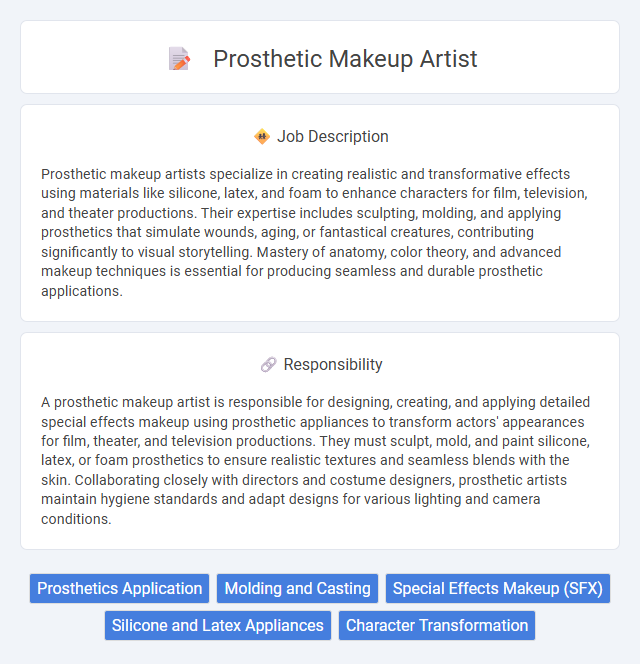
Prosthetic makeup artists specialize in creating realistic and transformative effects using materials like silicone, latex, and foam to enhance characters for film, television, and theater productions. Their expertise includes sculpting, molding, and applying prosthetics that simulate wounds, aging, or fantastical creatures, contributing significantly to visual storytelling. Mastery of anatomy, color theory, and advanced makeup techniques is essential for producing seamless and durable prosthetic applications.
Individuals with strong creativity, attention to detail, and steady hands will likely be suitable for a prosthetic makeup artist career, as precision is crucial in this field. Those who find it challenging to work with intricate materials or under time constraints might face difficulties adapting to the demands of prosthetic makeup work. Physical stamina may also play a role, since the job often requires long hours standing and applying complex prosthetics.
Qualification
Prosthetic makeup artists require specialized training in techniques such as molding, casting, and sculpting to create realistic prosthetics for film, television, and theater. Essential qualifications include proficiency in anatomy, color theory, and various materials like silicone and latex, often obtained through formal education or apprenticeships. Strong artistic skills, attention to detail, and experience with special effects makeup are critical for success in this highly creative and technical profession.
Responsibility
A prosthetic makeup artist is responsible for designing, creating, and applying detailed special effects makeup using prosthetic appliances to transform actors' appearances for film, theater, and television productions. They must sculpt, mold, and paint silicone, latex, or foam prosthetics to ensure realistic textures and seamless blends with the skin. Collaborating closely with directors and costume designers, prosthetic artists maintain hygiene standards and adapt designs for various lighting and camera conditions.
Benefit
Prosthetic makeup artists likely enjoy the benefit of creative expression through transforming actors into diverse characters, enhancing storytelling in film and theater. The profession may offer opportunities for collaboration with directors, actors, and special effects teams, fostering a dynamic and inspiring work environment. Financially, skilled prosthetic makeup artists could achieve competitive wages and job stability in industries that value realistic and innovative character designs.
Challenge
Prosthetic makeup artists likely face the challenge of transforming complex concepts into realistic, wearable designs that must withstand long hours on set. They probably need to adapt quickly to last-minute changes while maintaining high standards of detail and durability. Mastery of materials and techniques often proves essential to overcoming these demanding conditions.
Career Advancement
Prosthetic makeup artists can advance their careers by gaining specialized skills in silicone prosthetics, animatronics, and 3D printing technology. Building a strong portfolio with work on high-profile film and television projects increases visibility and opportunities for collaboration with top directors and designers. Networking within industry guilds and continuous education through workshops and advanced certifications significantly enhances prospects for leadership roles or freelance business growth.
Key Terms
Prosthetics Application
Prosthetic makeup artists specialize in the precise application of prosthetic appliances to transform actors into various characters, often using materials like silicone, latex, and foam. Mastery in blending edges seamlessly with natural skin and ensuring durability under different filming conditions is crucial for effective prosthetics application. Their skill greatly enhances visual storytelling by creating realistic wounds, creatures, or age effects essential for film, television, and theater productions.
Molding and Casting
Prosthetic makeup artists specialize in creating realistic facial and body prosthetics through advanced molding and casting techniques. Molding involves sculpting lifelike impressions of actors' features using materials like silicone or alginate, while casting requires pouring substances such as foam latex or gelatin into molds to produce durable, flexible prosthetic pieces. Mastery in molding and casting ensures seamless application and natural movement, enhancing character transformation in film, theater, and television productions.
Special Effects Makeup (SFX)
Prosthetic makeup artists specialize in creating realistic Special Effects Makeup (SFX) using materials like latex, silicone, and foam to transform actors into characters with wounds, creatures, or aging effects. Their expertise includes sculpting, molding, and painting prosthetic appliances to achieve seamless blending with natural skin, enhancing the visual storytelling in film, television, and theater. Mastery of color theory, anatomy, and advanced sculpting techniques is essential for delivering highly detailed and durable prosthetic applications that withstand long shooting schedules.
Silicone and Latex Appliances
Prosthetic makeup artists specializing in silicone and latex appliances create realistic effects for film, theater, and television by sculpting, molding, and applying custom prosthetics that mimic skin textures and movements. Mastery of silicone offers superior durability, translucency, and flexibility, making it ideal for lifelike wounds and character transformations, while latex appliances provide cost-effective, lightweight solutions with quick application times. Expertise in blending techniques, color matching, and seamless integration ensures these prosthetics enhance storytelling by transforming actors into believable creatures, injuries, or fantasy characters.
Character Transformation
Prosthetic makeup artists specialize in character transformation by applying custom-designed prosthetics that alter an actor's appearance to fit specific roles, such as aging, fantasy creatures, or injuries. They utilize materials like silicone, latex, and foam to create realistic textures and facial features, enhancing the storytelling experience in film, theater, and television. Expertise in sculpting, molding, and blending prosthetics seamlessly with natural skin ensures transformative and believable character designs.
 kuljobs.com
kuljobs.com